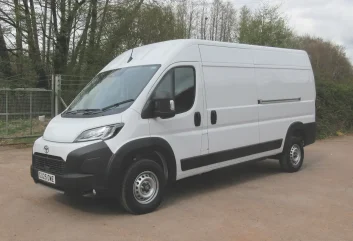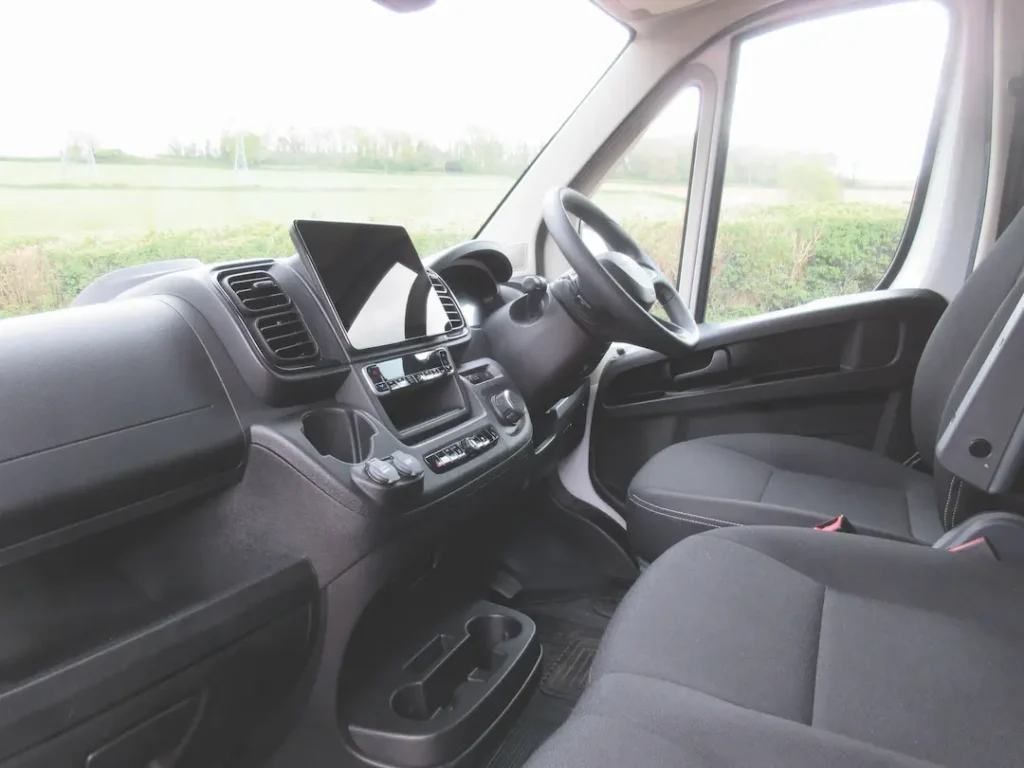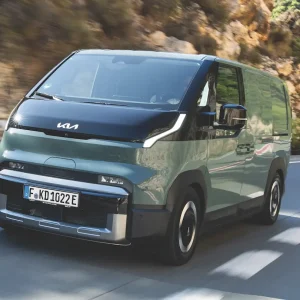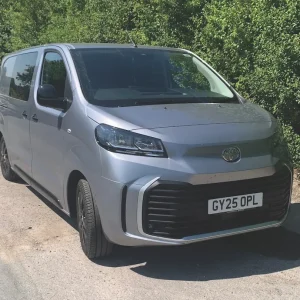
In recent years, Toyota has steadily expanded its light commercial line-up and now offers one of the most impressive ranges in the business. The biggest gap in its portfolio was the absence of a large panel van, but that has now been filled with the arrival of the Proace Max.
If it looks vaguely familiar, then that is not surprising. Like so much of the Toyota van stable, it is a rebadged version of a Stellantis model thanks to a deal the group has done with Toyota.
The Stellantis brands offer the same, recently upgraded vehicle as the Vauxhall Movano, Citroen Relay, Peugeot Boxer and Fiat Professional Ducato.
Opt for the diesel Proace Max and power comes courtesy of a 140hp 2.2-litre diesel married to either a six-speed manual or an eight-speed automatic gearbox. We chose to sample the electric Max EV, however, with a 274hp motor fed by a 110kWh lithium-ion NMC (nickel-manganese-cobalt) prismatic battery pack.
The Max EV is being marketed with a choice of two different lengths and two different heights. Van load cubes are 13.0m3 (L3/H2), 15.0m3 (L3/H3) and 17.0m3 (L4/H3) and a chassis cab is available too.
The need to ensure a respectable payload as a consequence of the weight of the battery means that they all gross at 4.25 tonnes. Thanks to a recent change in the regulations, they can now be driven on an ordinary Category B car driver’s licence without the need for extra training.
Toyota is selling the Max EV with only one level of trim – Icon. We got to grips with an L3/H2 Max EV van.
Loading and interior
Access to the cargo area is by means of a sliding nearside door or twin rear doors that can be swung through 180 degrees. There’s no shortage of load tie-down points – we counted eight set into the floor, two more at the base of the full-height steel bulkhead, three at waist-level on the offside, and two more at the same level on the nearside.
A shelf above the three-seater cab can be accessed from the cargo bay.
Icon trim encompasses a more-than-respectable level of specification with a 10in touchscreen with a DAB radio, satellite navigation, Apple CarPlay, Android Auto, Bluetooth connectivity and voice recognition.
A 7in multi-information instrument display for the driver is included in the deal along with automatic air-conditioning, rear parking sensors and a reversing camera. A push-button start and an electronic parking brake are both fitted.

While the touchscreen is important, we’re happy to say that it is not omnipotent. A separate set of switches controls the heating and ventilation system, including the air con, and allows you to switch the radio on and off and raise and lower the volume.
In-cab storage facilities include a lidded but not lockable glovebox, a lidded shelf on top of the dashboard and good-sized bins in each of the doors. Fold down the centre section of the middle passenger seat’s back and it turns into a desk.
Onboard safety packages include Pre-Collision System with pedestrian and cyclist detection which should make it less likely that you will run down vulnerable road users. Other safety features provided include Lane Departure Alert and Blind Spot Monitor.
The latter extends to a Move-Off Blind Spot Alert. If you are, for example, stationary at traffic lights, it warns you of the presence of people or bike riders standing or passing directly in front of you.
Performance and drive
Put some weight in the back before you take the Max EV anywhere. Without it, you will find the ride is bouncy and choppy to the point of discomfort, but just 400kg of cargo calms things down nicely and makes your journey a lot smoother.
For a comparatively large van, it handles well and we had no complaints about its on-highway performance. You can choose from three different driving modes – Eco, Normal or Power – and while hitting the Eco button strangles the performance of most light commercials, in this case it didn’t. As a result, we resorted to the Eco button far more than we expected to.
Noise levels were disappointing, with constant background drumming and humming from the bodywork. A diesel engine would have masked it. A near-silent electric motor cannot.
Charge up your van from 0% to 100% using an 11kW AC wallbox, and it will take around 10 hours, says Toyota. Get the battery from 0% to 80% using a 150kW DC rapid charger, however, and it should take no more than 55 minutes, the manufacturer adds.
If you want to pump some charge into the battery while you are driving then make use of the regenerative braking system, which harvests kinetic energy that would otherwise be lost when you slow down.
There are four levels to choose from that deliver different degrees of deceleration when you take your foot off the accelerator pedal. You select the level you prefer using paddles mounted behind the steering wheel.
The higher the level, the faster the van will slow down, and the more energy that will be recovered.
Toyota quotes a WLTP (Worldwide Harmonised Light Vehicle Test Procedure) standard range of 260 miles between recharges.
A big advantage of opting for a Toyota light commercial is the manufacturer’s clever approach to warranty cover. Once the initial three years/60,000 miles expires, it is automatically extended by 12 months/10,000 miles every time the vehicle undergoes a qualifying service at a Toyota dealership up to a limit of 10 years/100,000 miles.
It provides the customer with better warranty protection as well as providing Toyota workshops with more servicing revenue. So it’s a win-win.
| Model | Toyota Proace Max EV Icon L3H2 |
| Price (ex VAT and PIVG) | £51,349 |
| Price range (ex VAT and PIVG) | £51,349-£52,974 |
| Insurance group | 43E |
| Warranty | 3yrs/60,000 miles |
| Service intervals | 1yr/10, 000miles |
| Load length | 3,705mm |
| Load width (min/max) | 1,422mm/1,870mm |
| Load bay height | 1,932mm |
| Gross payload | 1,460kg |
| Load volume | 13m3 |
| Engine size/power | 274hp motor with 110kWh battery |
| Range (WLTP) | 260 miles |
| CO2 | 0g/km |
| On sale | September 2024 |
| Key rival | Ford E-Transit |
| Verdict | The level of equipment and the warranty are key reasons for considering this model over identical ones wearing different badges. |
| Score | 8/10 |





